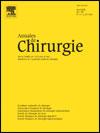Traitement de l'adénocarcinome du bas oesophage et du cardia : résection avec ou sans thoracotomie ? - 01/01/00
F. Mauvais, A. Sauvanet, V. Maylin, F. Paye, A. Sa Cunha, L. Dugué, J. BelghitiCorrespondance et tirés à part :
Ver las filiacionesResumen |
But de l'étude : Dans le traitement de l'adénocarcinome du cardia et du bas oesophage, le choix de la voie d'abord (avec ou sans thoracotomie) pour réaliser une oesogastrectomie polaire supérieure (OGPS) reste débattu. Le but de ce travail rétrospectif a été de comparer la mortalité, la morbidité et la survie à long terme dans une série de malades opérés avec ou sans thoracotomie.
Patients et méthode : De janvier 1991 à juin 1997, 59 malades (âge MOYEN = 65 ± 10 ans, extrêmes : 30-83) ont eu une OGPS avec (n = 31) ou sans thoracotomie (n = 28). Tous les malades ont eu un curage coeliaque et gastrique gauche, une gastroplastie tubulisée et une anastomose oesogastrique. Un curage médiastinal sous-aortique n'a été réalisé que chez les malades opérés avec thoracotomie. Les deux groupes étaient comparables concernant l'âge, la taille et le poids, le staging tumoral sur les données de l'imagerie et de l'histologie. Dans le groupe sans thoracotomie, il existait un nombre plus important de malades à haut risque (insuffisance respiratoire, score ASA = 3) (NS).
Résultats : La résection était palliative chez quatre malades du groupe avec thoracotomie et deux malades du groupe sans thoracotomie. La mortalité opératoire a été de 9 % avec thoracotomie et nulle sans thoracotomie (NS). Les complications pulmonaires étaient aussi fréquentes avec et sans thoracotomie (35 % contre 32 %). La survie actuarielle globale (résections curatives et palliatives) des malades à trois ans était identique dans les deux groupes (avec thoracotomie : 39 % contre sans thoracotomie : 46 %, NS), de même que la survie après résection curative (respectivement : 44 % contre 49 %, NS). Le type de l'intervention n'influençait pas la survie des malades N+ (respectivement 22 % contre 17 %, NS) et celle des malades N- (respectivement 86 % contre 77 %, NS).
Conclusion : Ces résultats suggèrent que, dans l'adénocarcinome du cardia et du bas oesophage, le bénéfice carcinologique théorique du curage médiastinal peut être mis en balance avec un risque opératoire plus important lié à la thoracotomie.
Mots clés : adénocarcinome du cardia ; intervention de Lewis ; oesogastrectomie polaire supérieure ; oesophagectomie sans thoracotomie.
Abstract |
Surgical treatment of adenocarcinoma of the cardia and lower oesophagus: resection with or without thoracotomy?
Study aim: In the treatment of adenocarcinoma of the cardia and lower oesophagus, the choice of the approach (with or without thoracotomy) to perform a proximal oesogastrectomy (POG) is still debated. The aim of this retrospective study was to compare mortality, morbidity and long-term survival in a series of patients operated on with or without thoracotomy.
Patients and method: From January 1991 to June 1997, 59 patients (mean ages: 65 ± 10 years, range: 30-83) underwent POG through a transthoracic (n = 31) or a transhiatal approach (n = 28). All patients underwent both coeliac and left gastric lymphadenectomy. A mediastinal subaortic lymphadenectomy was only performed in patients who had a transthoracic approach. Both groups were comparable concerning age, weight and height, and tumoral staging according to preoperative imaging and pathologic examination. The transhiatal group included more high-risk patients (respiratory insufficiency, ASA score = 3) (NS).
Results: Resection was palliative in four patients in the transthoracic group and two patients in the transhiatal group. Operative mortality was 9% in the transthoracic group and 0% in the transhiatal group (NS). Pulmonary complications were as frequent with and without thoracotomy (35% versus 32% respectively). Global (curative and palliative resections) 3-year actuarial survival was similar in both groups (transthoracic: 39% versus transhiatal: 46%, NS), as well as survival after curative resection (44% versus 49% respectively, NS). The operative approach did not influence survival in patients N+ (22% versus 17% respectively, NS) and in patients N- (86% versus 77% respectively, NS).
Conclusion: These results suggest that, for adenocarcinoma of the cardia and lower oesophagus, the theorical carcinologic benefit of mediastinal lymphadenectomy can be balanced with an higher operative risk related to the transthoracic approach.
Mots clés : adenocarcinoma of the cardia ; Lewis procedure ; oesophagectomy without thoracotomy ; proximal oesogastrectomy.
Esquema
Vol 125 - N° 3
P. 222-230 - avril 2000 Regresar al númeroBienvenido a EM-consulte, la referencia de los profesionales de la salud.

